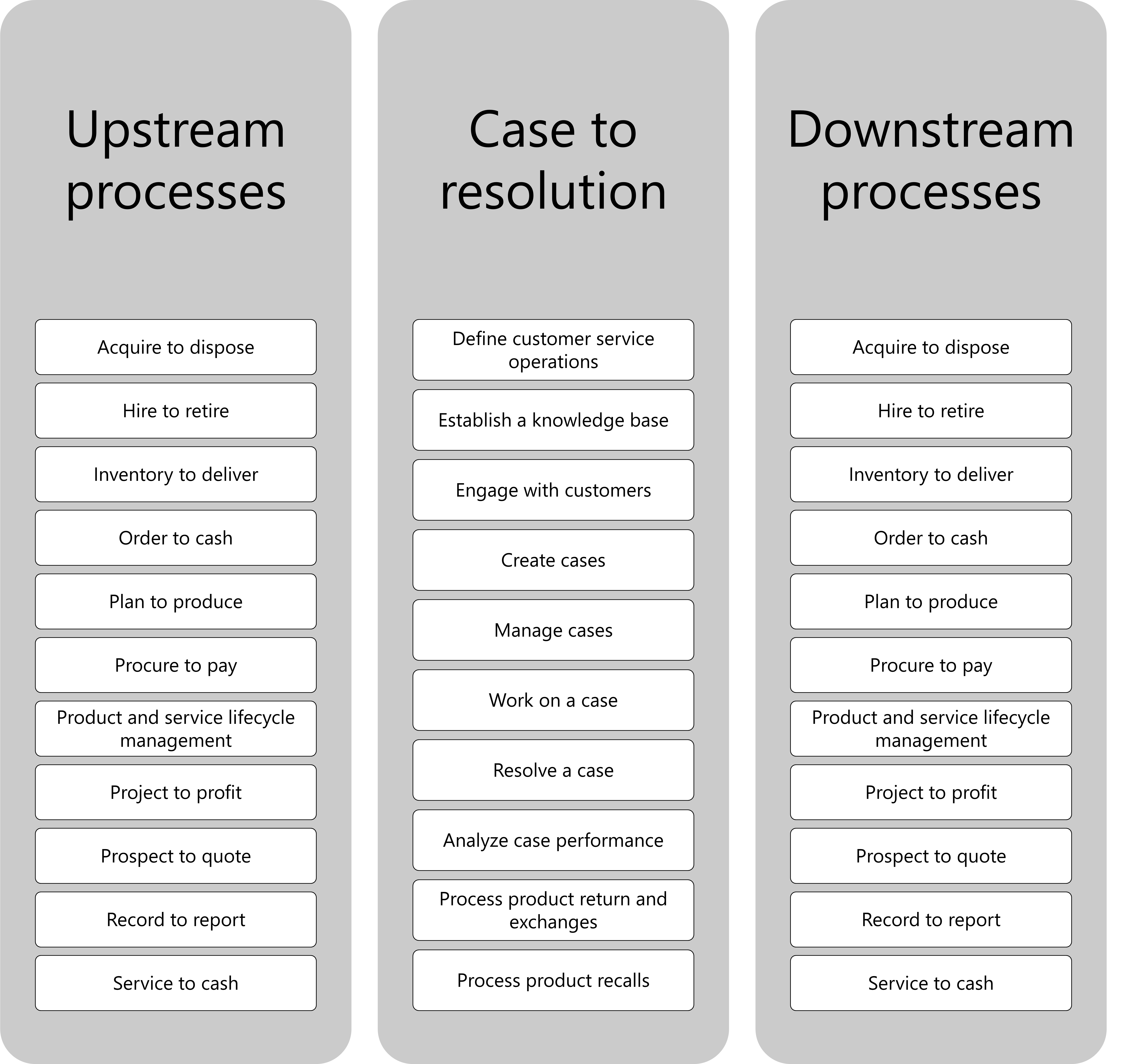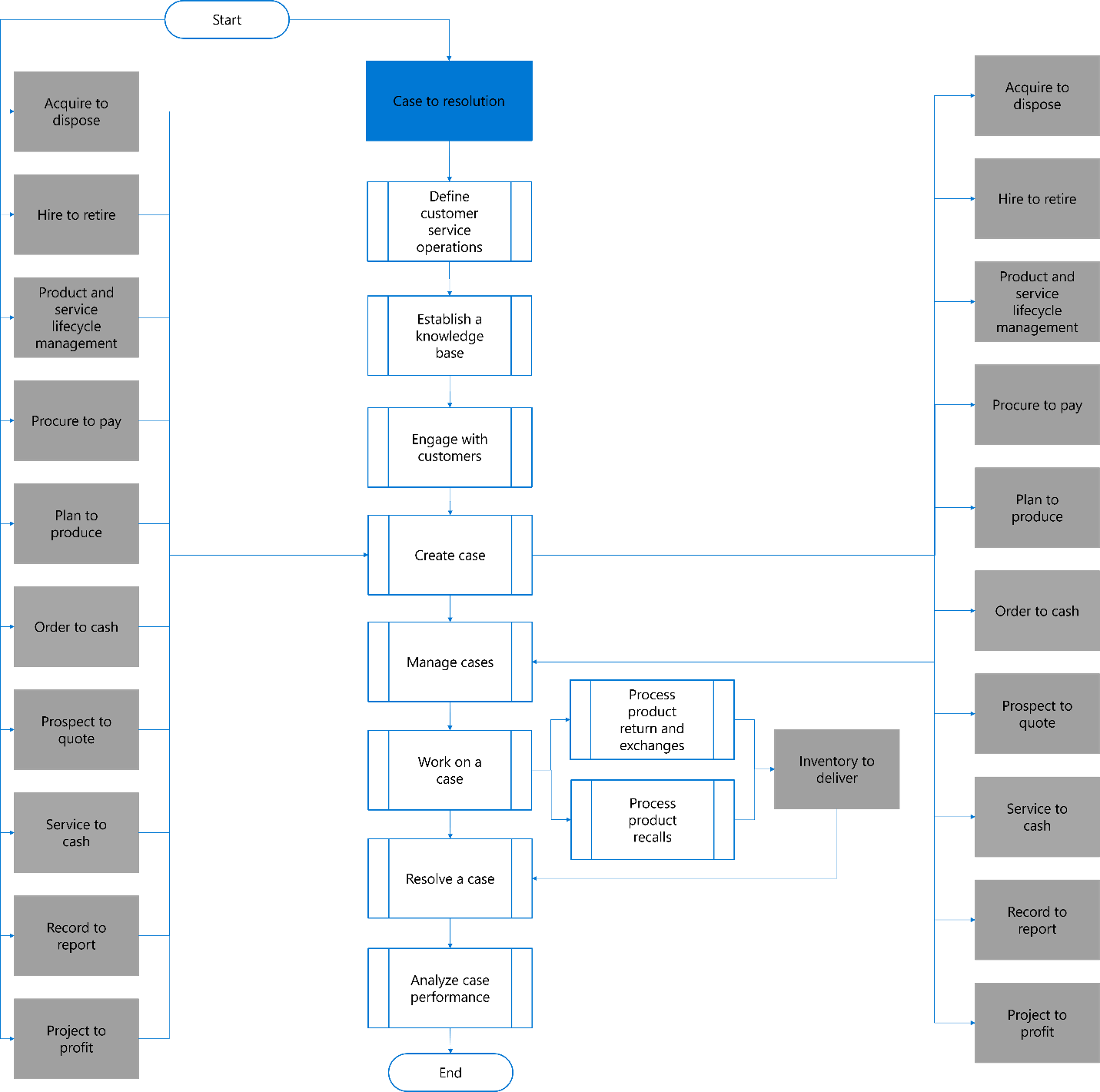Overview of case to resolution end-to-end business process flow
Applies to: Dynamics 365 Commerce, Dynamics 365 Customer Insights, Dynamics 365 Customer Service, Dynamics 365 Customer Service Insights, Dynamics 365 Customer Voice, Dynamics 365 Field Service, Dynamics 365 Finance, Dynamics 365 Human Resources, Dynamics 365 Project Operations, Dynamics 365 Remote Assist, Dynamics 365 Sales, Dynamics 365 Supply Chain Management
This article describes the case to resolution end-to-end business process flow and its relationship to other business processes that can be used within Dynamics 365.
Case to resolution process relationship
The following diagram shows the relationship of other processes and products/features for the case to resolution process.
The first column of this diagram shows potential upstream processes for the case to resolution process including the following:
Acquire to dispose
When cases involve operations with fixed assets or customers assets, the acquire to dispose process is upstream to include the process of creating the assets and log asset installations, uninstallations or replacements at owned sites or customer locations.
Concept to market
Case investigations may lead to product quality reviews to diagnose service issues that must be addressed in the service development process.
Design to retire
Case investigations may lead to product quality reviews to diagnose product issues that must be addressed in the product development process.
Hire to retire
In the hire to retire process, you use cases to manage employee requests, manager requests, and other back office operations, such as leave, absence, or benefits processes.
Inventory to deliver
In any organization that handles tangible products, the inventory to deliver process may include cases that are either internal or external in nature. For example, vendor quality, customer issues, or production related cases.
Order to cash
The case to resolution process can be upstream when you need to create cases related to accounts, sales orders, leads, and so on.
Plan to produce
You can use case management with production orders to help manage your production process.
Source to pay
The case to resolution process can be upstream when you need to create cases related to suppliers, purchase orders, purchase requisitions, requests for quotations, and so on.
Project to profit
When you use projects to manage internal or external projects, cases can be a critical part of the process to manage requests and issues.
Record to report
Case management can be a critical tool in coordinating resolutions and refund for example, with many other business processes.
Service to cash
The case to resolution process is often tightly integrated with the service to cash process as a tool to help resolve issues with customer assets, products, warranties, and so on.
The second column in the graphic shows the business process areas that are part of the case to resolution process.
Define customer service operations
Establish a knowledge base
Engage with customers
Create a case
Manage cases
Work on a case
Resolve a case
Analyze case performance
Process product returns and exchanges
Process product recalls
The third and last column in the diagram displays the downstream business process including the following the same list that is shown in column one for the upstream processes. This is because there's much flexibility in the process flow your organization can use to manage requests and issues. In some cases, the case may be a prerequisite for completing another process, in others, the case might happen after another process is already complete.
Featured capabilities
There are product specific capabilities offered that interact with the case to resolution to process including, but not limited to, the following:
Omnichannel for Customer Service
Allows customers to contact support through multiple channels, streamlining the case resolution process and providing a consistent experience.
Nuance Gatekeeper
Provides biometric customer authentication by understanding customer voice tone, manners and wording during voice and messaging conversations.
Knowledge Base management
A robust knowledge base authoring, curation, and publishing tool, which can also be configured to crawl external knowledge bases created in content services like SharePoint.
Smart Assist Bot
An Azure Bot integrated to Customer Service Workspace to assist agents during customer conversations
Unified routing
Efficiently directs conversations and cases to the right agent or team using a variety of criteria including rules, skills matching and agent capacity, reducing wait times and improving resolution times.
Microsoft Teams for collaboration
Enables support agents to collaborate in real-time with subject matter experts (SME), share information, and solve cases faster
AI Suggestions
Allows Customer Service Workspace to suggest articles and cases based on latest messages in a conversation.
Dynamics 365 Customer Insights
Builds a unified customer profile with data from multiple sources and provides a consolidate 360-degree view of customer so agents can have a comprehensive view of who they are servicing when dealing with a customer request.
Dynamics 365 Customer Service Insights
Provides actionable insights and analytics to help teams identify trends, optimize processes, and improve the overall customer experience.
Dynamics 365 Customer Voice
Provides an end-to-end survey management tool that can be used in multiple scenarios including post-case customer satisfaction surveys.
Agents and Azure Bots
Automates routine tasks, allows for self-service options, and frees up support agents to focus on more complex cases.
Connected Customer Service for IoT Center and Hub
Allows support teams to proactively identify and resolve issues with connected devices, reducing downtime and improving customer satisfaction.
Returns, RMA's and Exchanges
Sales Returns in Dynamics 365 Finance and Operations provides capabilities to process return orders for physical return or credit-only processes, as well as Return Material Authorizations (RMA) and Replacement order creation, in advance or upon return, for product exchanges.
Case to resolution business process flow
The following diagram shows the high-level flow of the case to resolution business process. Each solid rectangle on the diagram represents an end-to-end business process area. The diagram shows the subprocesses for the end-to-end business process in this article. The arrows on the diagram show the flow of the business process in a typical organization. If a subprocess can lead to more than one other subprocess, the parallel subprocesses are shown as branches.
The following steps are illustrated in the case to resolution end-to-end business process flow diagram.
Start
Case to resolution
Define customer service operations
Establish a knowledge base
Engage with customers
Create a case
Manage a case
Work on a case
Process product return and exchanges
Process product recalls
Inventory to deliver
Resolve a case
Analyze case performance
End
Start has parallel branches to each of the following end-to-end processes (shown on the left side of the diagram)
Acquire to dispose
Hire to retire
Product and service lifecycle management
Source to pay
Plan to produce
Order to cash
Prospect to quote
Service to cash
Record to report
Project to profit
Each of these boxes has a branch that connects to 6. Create a case.
Source to pay, Plan to produce, and Order to cash each have a parallel branch connecting to Inventory to deliver, which also connects to 6. Create a case.
Create a case has parallel branches to each of the end-to-end processes a-j (shown on the right side of the diagram)
Each of the end-to-end processes a-j have parallel branches connecting 7. Manage a case (shown on the right side of the diagram).
Next steps
If you would like to implement Dynamics 365 solutions to assist with your case to resolution business processes, you can use the following resources and steps to learn more.
Define the goals and objectives of implementing an case to resolution technology solution. Learn more at Implementation strategy.
Define the business process scope of your project. Learn more at Process-focused solution.
Request a demo or get a free trial of Microsoft Business Applications solutions for the case to resolution process. Learn more at Request a demo.
Get an introduction of the case to resolution business process. Learn more at Case to resolution introduction.
Get an overview of the case to resolution business process areas. Learn more at Case to resolution business process areas
Related information
You can use the following resources to learn more about the case to resolution process in Dynamics 365.

